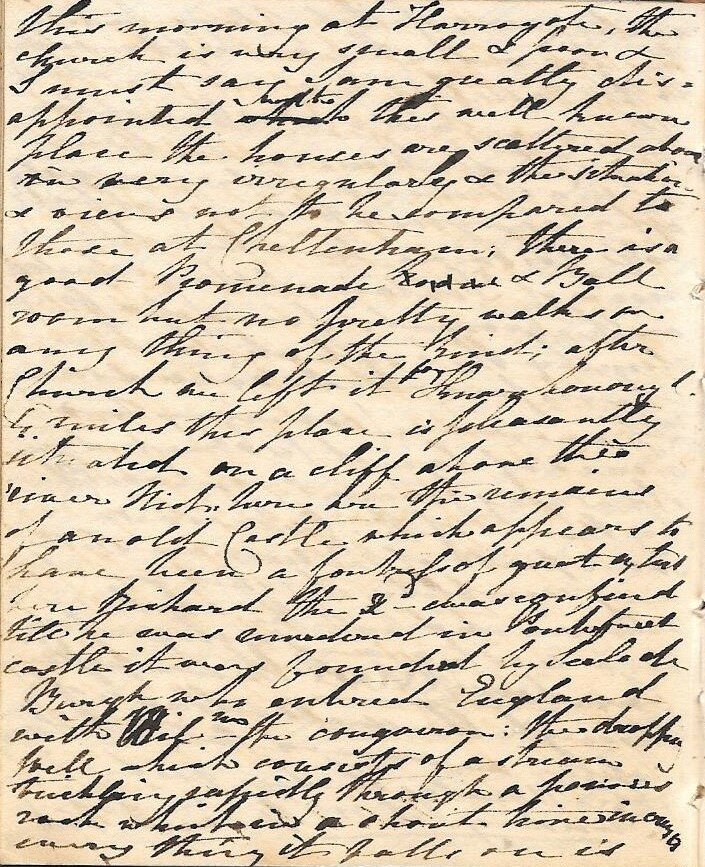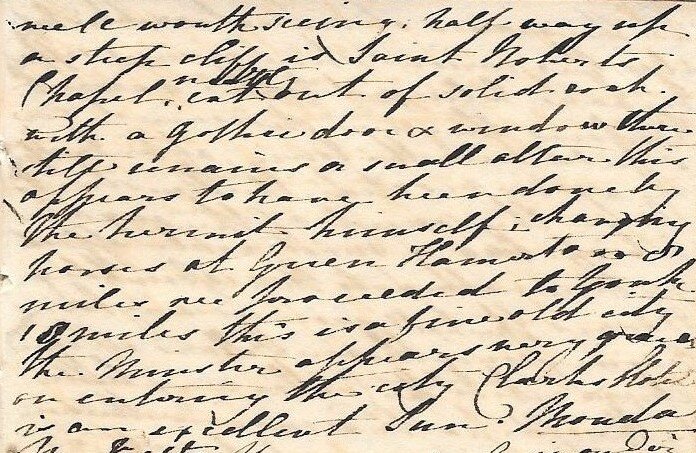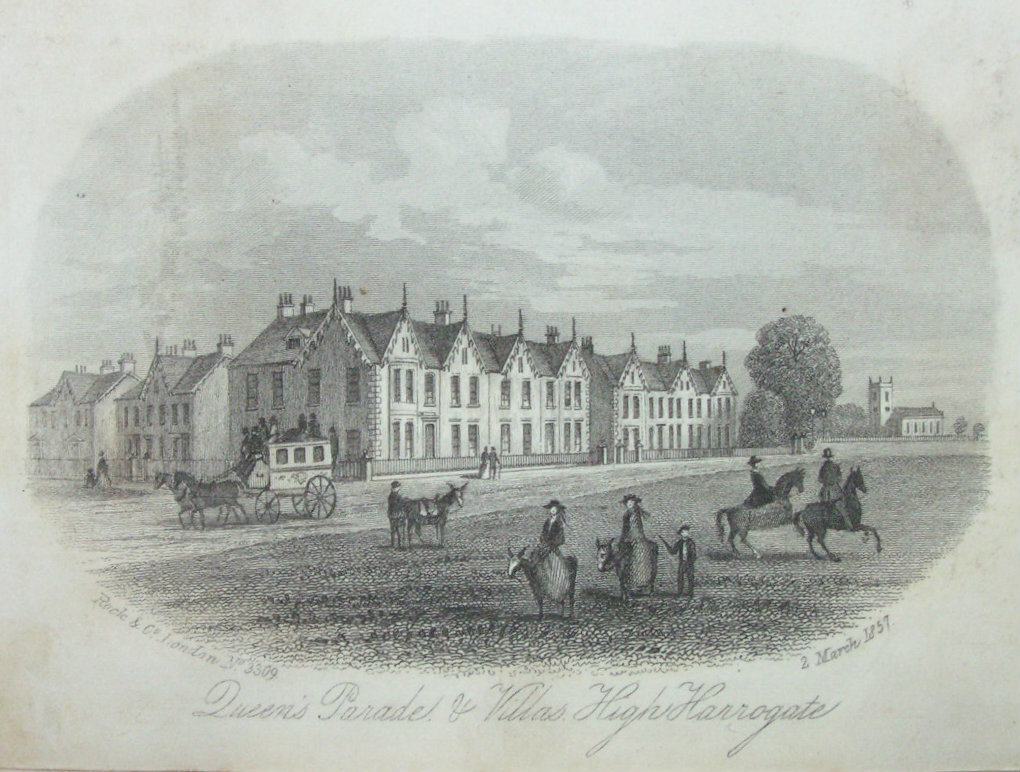Sunday 31st October 1819
Sunday Oct 31st we went to church
this morning at Harrogate the church is very small & poor & I must say I am greatly disappointed with this well known place the houses are scattered about very irregularly & the situation & views not to be compared to those at Cheltenham; there is a good Promenade & Ball room but no pretty walks or anything of the kind; after Church we left it for Knaresborough 4 miles this place is pleasantly situated on a cliff above the river Nidd here are the remains of an old Castle which appears to have been a fortress of great extent here Richard the 2nd was confined till he was murdered in Pontefract Castle it was founded by Serlo de Burgh who entered England with Wilm the conqueror: the dropping well which consists of a stream trickling rapidly through a porous rock which in a short time incrusts every thing it falls on is
well worth seeing. half way up a steep cliff is Saint Roberts Chapel neatly cut out of solid rock with a gothic door & window there still remains a small altar this appears to have been done by the hermit himself; changing horses at Green Hammerton 8 miles we proceeded to York 18 miles this is a fine old city the Minster appears a very grand on entering the city Clarks Hotel is an excellent Inn,
OBSERVATIONS & COMMENTS:
Christ Church, High Harrogate was the first permanent church building in Harrogate. Originally a chapel of ease to St John's, Knaresborough, the bulk of the present building was erected in 1831. Lucy would have attended the chapel of ease, whose vicar at the time was Robert Mitton. Perhaps Lucy’s feelings about its size and poor condition was shared by the community leading to the rebuilding in 1831. https://en.wikipedia.org/wiki/Christ_Church,_High_Harrogate
1853: Christ Church, High Harrogate . Engraver: Rock & Co http://www.rareoldprints.com/p/3830
2010: Christ Church parish church, Harrogate, North Yorkshire, seen from the southeast by Rachael Meyer (Frnjh at en.wikipedia) This file is licensed under the (CC-BY-SA-3.0. ) Creative Commons Attribution-Share Alike 3.0 Unported license. https://commons.wikimedia.org/wiki/File:Christ_Church_Harrogate_-_17.9.10.jpg
Harrogate: In the early 19th century Low Harrogate overtook High Harrogate in popularity.
1796: Low Harrogate . Artist: Francis Nicholson. Engraver & Publisher: J Walker http://www.rareoldprints.com/z/14418
The sulphur well was improved with the erection of a covered well head in 1803 and three years later the first Assembly Rooms, with a promenade room for visitors resorting to the Spa, were built to provide a promenade for visitors. http://www.friendsofvalleygardens.co.uk/page17/page5/page5.html
1857: Queen's Parade & Villas, High Harrogate . Engraver: Rock & Co. http://www.rareoldprints.com/z/3835
The Assembly rooms would probably be where balls were held, although many of the grand hotels of the day had their own ballrooms.
Royal Baths Assembly Rooms, Harrogate, Yorkshire. This splendid building is one of Yorkshire's premier venues, and is used for a variety of events - here, for an international Youth Music festival. © Copyright Dr Neil Clifton and licensed for reuse under the (CC BY-SA 2.0. ) Creative Commons Licence. https://www.geograph.org.uk/photo/412552
Knaresborough is a market and spa town on the River Nidd 4 miles east of Harrogate.
1828: Knaresborough, from the Bridge. http://www.rareoldprints.com/z/19803
Knaresborough Riverside The River Nidd flows below the town and St John the Baptist's Church © Copyright Graham Hogg and licensed for reuse under the (CC BY-SA 2.0. ) Creative Commons Licence. https://www.geograph.org.uk/photo/3633016
Sights in the town include the remains of Knaresborough Castle, the Courthouse Museum in the castle grounds, Mother Shipton's Cave, the House in the Rock, St Robert's Cave (dating from the Middle Ages).
Perspective View of the Dripping Well, & Ruins of Knaresbrough-Castle, in Yorkshire. From Mod Universal British Traveller (1779-1790c). http://www.rareoldprints.com/z/16642
The Chapel of Our Lady of the Crag on Abbey Road was dedicated to the Virgin Mary and built in 1408 by John the Mason after his son, who was presumed dead in a rockfall in a local quarry, was found alive, with the son's escape having been attributed to the mason's frequent prayers to Mary. Knaresborough is the site of Ye Oldest Chymist Shoppe in England, opened in 1720. https://en.wikipedia.org/wiki/Knaresborough
River Nidd is a tributary of the River Ouse that meanders through Knaresborough, overlooking the castle. https://en.wikipedia.org/wiki/River_Nidd
River Nidd, Knaresborough . Looking down the River Nidd, near Knaresborough Viaduct. © Copyright Wayland Smith and licensed for reuse under the (CC BY-SA 2.0. ) Creative Commons Licence. https://www.geograph.org.uk/photo/4489242
Knaresborough Castle was first built by a Norman baron in c. 1100 on a cliff above the River Nidd. There is documentary evidence dating from 1130 referring to works carried out at the castle by Henry I. In the 1170s Hugh de Moreville and his followers took refuge there after assassinating Thomas Becket. In 1205 King John took control of Knaresborough Castle and spent £1,290 on improvements. It was later rebuilt at a cost of £2,174 between 1307 and 1312 by Edward I and later completed by Edward II, including the great keep. Philippa of Hainault took possession of the castle in 1331, at which point it became a royal residence. The queen often spent summers there with her family. Her son, John of Gaunt acquired the castle in 1372, adding it to the vast holdings of the Duchy of Lancaster. Katherine Swynford, Gaunt's third wife, obtained the castle upon his death. It was taken by Parliamentarian troops in 1644 during the Civil War, and largely destroyed in 1648 not as the result of warfare, but because of an order from Parliament to dismantle all Royalist castles.
Knaresborough Castle. Album 1, Castles: Knaresborough. Engraver: Rock & Co http://www.rareoldprints.com/z/2396
Knaresborough Castle © Copyright habiloid and licensed for reuse under the (CC BY-SA 2.0. ) Creative Commons Licence. https://www.geograph.org.uk/photo/6194873
Many town centre buildings are built of 'castle stone'. https://en.wikipedia.org/wiki/Knaresborough_Castle
Serlo de Burgh was granted the Manor of Knaresborough by William the Conqueror as a reward for his part in the invasion. http://knaresborough.co.uk/history/
"Old Mother Shipton's Cave" is at Knaresborough, near to a petrifying well which is the oldest entrance-charging tourist attraction in England, open since 1630.
1855: Dropping Well, Knaresbo'. Engraver: Rock & Co http://www.rareoldprints.com/z/2399
The water of the well is rich in sulphate and carbonate[1] which is deposited as a ramp and screen below, and in which artefacts are "petrified" (encrusted) as a tourist attraction. The place is associated with the legendary soothsayer and prophetess Mother Shipton (c. 1488 - 1561), who, according to legend, was born in the cave.
2010: The entrance to the cave in Knaresborough in which according to legend Mother Shipton was born. By chris, the copyright holder of this work, published under the (CC BY-SA 3.0) Creative Commons Attribution 3.0 Unported license. https://commons.wikimedia.org/wiki/File:MotherShipton%27sCave.jpg
The cave and dropping well, together with other attractions, remain open to visitors and are run by Mother Shipton's Cave Ltd https://en.wikipedia.org/wiki/Mother_Shipton%27s_Cave
Saint Roberts Chapel: Known for his charity to the poor and destitute, St Robert of Knaresborough (c. 1160 – 1218) attracted followers wherever he settled but ran into trouble with the Constable of Knaresborough Castle, William de Stuteville. As a result, Robert came to live in a cave by the river Nidd. His reputation as a holy man and miracle worker attracted many pilgrims to this hermitage. Giving in to public opinion, the Constable of the castle granted Robert a piece of land and he lived in the cave for the rest of his life, with a chapel built nearby. https://www.harrogate.gov.uk/info/20153/knaresborough_castle_and_museum/715/st_roberts_cave_knaresborough
St Robert's Chapel, Knaresborough . This is the remains of a cave between the riverside lane and the River Nidd. St Robert was the son of a mayor of York, and was born c.1160 and died in 1218. He spent most of his life as a hermit in the cave, most of which has been eroded and washed away by the river. What remains are the access steps, altar and stone bed - too small for him to be able to lie straight. © Copyright Humphrey Bolton and licensed for reuse under the (CC BY-SA 2.0. ) Creative Commons Licence. https://www.geograph.org.uk/photo/85311
Green Hammerton Inn: They would probably have changed horses at The Bay Horse Inn, Green Hammerton, “a traditional English Inn that dates back to the 17th century”, equidistant between Harrogate and York. https://www.bayhorsegreenhammerton.co.uk/
The Bay Horse, Green Hammerton. Village pub with accommodation in a separate building to the rear. © Copyright Stephen McKay and licensed for reuse under the (CC BY-SA 2.0. ) Creative Commons Licence. https://www.geograph.org.uk/photo/936460
York, founded in 71 AD, was proclaimed capital of the province of Britannia Inferior by Emperor Severus. In 866 the Vikings raided and captured York. Under Viking rule the city became a major river port, part of the extensive Viking trading routes throughout northern Europe. In 1068, two years after the Norman conquest of England, the people of York rebelled. Initially they were successful, but upon the arrival of William the Conqueror the rebellion was put down. Early castles were destroyed in 1069 and rebuilt by William about the time of his ravaging Northumbria in his "Harrying of the North" where he destroyed everything from York to Durham. The remains of the rebuilt castles, now in stone, are visible on either side of the River Ouse. The first stone minster church was badly damaged by fire in the uprising, and the Normans built a minster on a new site. Around the year 1080, Archbishop Thomas started building the cathedral that in time became the current Minster. In the 12th century York started to prosper. In 1190, York Castle was the site of an infamous massacre of its Jewish inhabitants, in which at least 150 Jews died (although some authorities put the figure as high as 500). Guy Fawkes, who was born and educated in York, was a member of a group of Roman Catholic restorationists that planned the Gunpowder Plot to blow up the Houses of Parliament while King James I, the entire Protestant, and even most of the Catholic aristocracy and nobility were inside. In 1644, during the Civil War, the Parliamentarians besieged York, and many medieval houses outside the city walls were lost. The barbican at Walmgate Bar was undermined and explosives laid, but, the plot was discovered. After the restoration of the monarchy the city's role as the social and cultural centre for wealthy northerners was on the rise.
1866: York, from the City Walls. Engraving by Rock & Co. London. Published 20th March, 1866 with later hand colouring. https://antique-prints-maps.com/acatalog/ref1.php?imagefile=../largeimages/SEYorkFromCityWalls.jpgb
York's many elegant townhouses, such as the Lord Mayor's Mansion House and Fairfax House date from this period, as do the Assembly Rooms, the Theatre Royal, and the racecourse. The Assize of Ale is an annual event in the city where people in medieval costume take part in a pub crawl to raise money for local charities. It has its origins in the 13th century, when an Assize of Bread and Ale was used to regulate the quality of goods. The oldest Inns include the Golden Fleece, Ye Olde Starre Inne, noted for its sign which has spanned the street since 1733, and The Kings Arms, often photographed during floods. https://en.wikipedia.org/wiki/York
York City Walls and Lendal Bridge . © Copyright Steve Daniels and licensed for reuse under the (CC BY-SA 2.0. ) Creative Commons Licence. https://www.geograph.org.uk/photo/1261120
Clarks Hotel: There is no mention of a Clarks Hotel in the comprehensive Visit York publication, Historic Inns and Pubs of York http://mediafiles.thedms.co.uk/Publication/YK/cms/pdf/12-media-culture-Historic%20Inns%20and%20Pubs%20of%20York%202013.pdf and none appear in searches of Georgian hotels.
Can you help us?
Old Regency Prints, Pictures an Coaching maps: Do you have access to any prints or pictures showing what town and country would have looked like when Lucy travelled through? Any illustrations of what she would have seen in 1819 will enliven our research.
New Pictures: Do you have any modern pictures of the streets, buildings, gardens and views that would enable us to see the changes that two centuries have wrought?



















